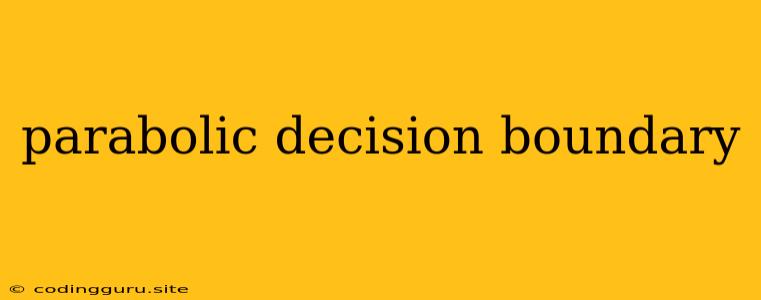Understanding Parabolic Decision Boundaries: A Deeper Dive
In the realm of machine learning, decision boundaries play a crucial role in classifying data points into distinct categories. These boundaries, often represented as lines or curves, demarcate the regions where different classes reside. While linear decision boundaries are commonly encountered in simple classification tasks, certain datasets require more complex boundaries to effectively separate the classes. Enter the parabolic decision boundary, a powerful tool for capturing non-linear relationships within data.
But what exactly is a parabolic decision boundary, and why is it so important? Let's break it down:
What is a Parabolic Decision Boundary?
A parabolic decision boundary is a curve shaped like a parabola that separates data points belonging to different classes. Unlike a linear decision boundary, which is a straight line, a parabolic boundary allows for a more flexible separation of data points that exhibit non-linear relationships. This flexibility is crucial when dealing with datasets where a simple linear model fails to capture the underlying patterns.
Why Use a Parabolic Decision Boundary?
Consider a scenario where you're trying to classify images of animals. You have two classes: dogs and cats. If you were to use a linear decision boundary, you might find that certain images with similar characteristics (e.g., a large, furry animal) might be misclassified. This is because linear boundaries are limited to straight lines, which may not accurately represent the complexities of the data.
A parabolic decision boundary, on the other hand, can curve around these misclassified points, creating a more accurate separation between the dog and cat classes. This flexibility allows for better classification accuracy by capturing non-linear relationships within the data.
How is a Parabolic Decision Boundary Achieved?
To achieve a parabolic decision boundary, you need a machine learning model that can learn non-linear functions. One such model is the polynomial regression model, which allows for the inclusion of polynomial terms in the decision boundary equation. This results in a curved boundary that can better fit the shape of the data.
Example: A Practical Application
Imagine you're trying to predict the price of a house based on its size and age. You might find that the relationship between these variables is not linear. Smaller houses might be priced higher than larger houses if they are very old and located in a desirable neighborhood. This non-linear relationship can be captured by a parabolic decision boundary.
By using a polynomial regression model with a parabolic decision boundary, you can create a more accurate model that accounts for the non-linear relationship between house size, age, and price.
Key Takeaways:
- Parabolic decision boundaries are crucial for effectively classifying data with non-linear relationships.
- Polynomial regression models can be used to achieve parabolic decision boundaries.
- These boundaries are valuable for applications where linear models fail to capture the complexity of the data.
Conclusion
In conclusion, parabolic decision boundaries offer a powerful tool for separating data points with non-linear relationships. They provide greater flexibility and accuracy than linear boundaries, enabling better classification performance. By understanding the concept of parabolic decision boundaries and how to achieve them through models like polynomial regression, you can unlock new possibilities for data analysis and decision making in machine learning applications.
